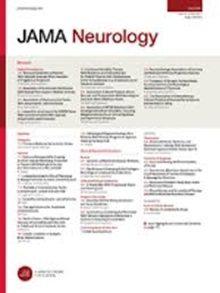抗iglon5疾病患者早期静脉注射免疫球蛋白治疗及预后
IF 21.3
1区 医学
Q1 CLINICAL NEUROLOGY
引用次数: 0
摘要
抗iglon5疾病是一种自身免疫性脑病,常导致严重残疾或死亡。免疫疗法的疗效尚不清楚。目的探讨早期免疫治疗是否与抗iglon5疾病致残和死亡相关。设计、环境和参与者这项针对抗iglon5疾病患者的回顾性多中心队列研究于2014年至2024年进行,中位(IQR)随访时间为疾病发病后66(33-97)个月。分析了来自德国自身免疫性脑炎登记处研究网络、巴塞罗那大学医院诊所(西班牙)和伊拉斯谟大学医学中心(荷兰)的数据。入选标准是符合抗IgLON5疾病的临床特征以及血清或脑脊液中存在IgLON5抗体。数据由主治医生使用结构化问卷收集。从参与中心和登记处系统选择的121例患者中,有14例患者因临床信息不足或撤回同意而被排除在外。干预:根据治疗医生的决定启动免疫治疗。在最近的随访中,使用改良的Rankin量表(mRS)评估临床残疾和患者死亡比例。结果107例抗iglon5疾病患者中,女性46例(43.0%),男性61例(57.0%);发病时的中位年龄[IQR]为64[57-70]岁),25例(23.4%)患者在发病第一年接受免疫治疗,57例(53.3%)患者在发病后接受免疫治疗。在早期治疗的患者中,静脉注射免疫球蛋白9例(36.0%),利妥昔单抗13例(52.0%)。共有44例(41.1%)患者死亡,其中至少三分之二的死亡与抗iglon5疾病有关(28例[63.6%])。早期免疫治疗是与较低的长期残疾相关的唯一可改变的独立因素(优势比,0.32;95% ci, 0.13-0.83;P = .02)和生存率(优势比2.70;95% ci, 0.99-7.69;p = .047)。在最近的随访中,只有在发病一年内开始静脉注射免疫球蛋白与较低的中位(IQR) mRS评分相关(2 [1-2.5]vs 3 [2-6];p = .005;R = 0.55)和较低的死亡比例(9例患者中0例vs 16例患者中6例[37.5%];P = .04),与其他早期免疫疗法相比,尽管基线mRS评分相似。在这项研究中,早期开始静脉注射免疫球蛋白(在发病的第一年)与抗iglon5疾病的良好长期预后和生存率提高相关。需要更大规模的前瞻性研究来验证这一发现。本文章由计算机程序翻译,如有差异,请以英文原文为准。
Early Treatment With Intravenous Immunoglobulins and Outcomes of Patients With Anti-IgLON5 Disease.
Importance
Anti-IgLON5 disease is an autoimmune encephalopathy that often leads to severe disability or death. The efficacy of immunotherapy remains unknown.
Objective
To investigate whether early immunotherapy is associated with disability and death in anti-IgLON5 disease.
Design, Setting, and Participants
This retrospective, multicenter cohort study of patients with anti-IgLON5 disease was conducted from 2014 to 2024, with a median (IQR) follow-up of 66 (33-97) months after disease onset. Data from the German Network for Research on Autoimmune Encephalitis Registry, University Hospital Clinic of Barcelona (Spain), and Erasmus University Medical Center (the Netherlands) were analyzed. Eligibility criteria were clinical features consistent with anti-IgLON5 disease and the presence of IgLON5 antibodies in serum or cerebrospinal fluid. Data were collected by treating physicians using a structured questionnaire. Of 121 patients systematically selected from participating centers and registries, 14 patients were excluded due to insufficient clinical information or withdrawal of consent.
Intervention
Initiation of immunotherapy based on the treating physician's decision.
Main Outcomes and Measures
Clinical disability was assessed using the modified Rankin Scale (mRS) at the most recent follow-up visit and the proportion of patients who died.
Results
Among 107 patients with anti-IgLON5 disease (46 female [43.0%] and 61 male [57.0%]; median [IQR] age at the time of disease onset, 64 [57-70] years), 25 patients (23.4%) received immunotherapy during the first year of disease onset and 57 patients (53.3%) received it later. Among early treated patients, 9 individuals (36.0%) received intravenous immunoglobulins and 13 individuals (52.0%) received rituximab. A total of 44 patients (41.1%) died, and at least two-thirds of these deaths were related to anti-IgLON5 disease (28 patients [63.6%]). Early immunotherapy was the only modifiable independent factor associated with a lower long-term disability (odds ratio, 0.32; 95% CI, 0.13-0.83; P = .02) and survival (odds ratio, 2.70; 95% CI, 0.99-7.69; P = .047). Only intravenous immunoglobulin started within the first year of disease onset was associated with a lower median (IQR) mRS score at the most recent follow-up (2 [1-2.5] vs 3 [2-6]; P = .005; r = 0.55) and a lower proportion of deaths (0 of 9 patients vs 6 of 16 patients [37.5%]; P = .04) compared with other early immunotherapies despite a similar baseline mRS score.
Conclusions and Relevance
In this study, early initiation of intravenous immunoglobulins (within the first year of onset) was associated with favorable long-term outcomes and improved survival in anti-IgLON5 disease. Larger prospective studies are needed to validate this finding.
求助全文
通过发布文献求助,成功后即可免费获取论文全文。
去求助
来源期刊

JAMA neurology
CLINICAL NEUROLOGY-
CiteScore
41.90
自引率
1.70%
发文量
250
期刊介绍:
JAMA Neurology is an international peer-reviewed journal for physicians caring for people with neurologic disorders and those interested in the structure and function of the normal and diseased nervous system. The Archives of Neurology & Psychiatry began publication in 1919 and, in 1959, became 2 separate journals: Archives of Neurology and Archives of General Psychiatry. In 2013, their names changed to JAMA Neurology and JAMA Psychiatry, respectively. JAMA Neurology is a member of the JAMA Network, a consortium of peer-reviewed, general medical and specialty publications.
 求助内容:
求助内容: 应助结果提醒方式:
应助结果提醒方式:


